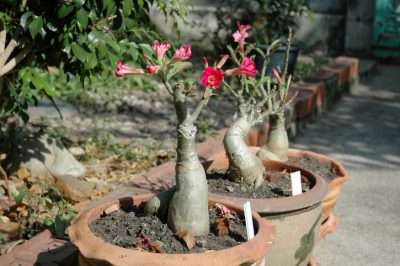Only in the spring it was sown from a tiny and inconspicuous seed. In early summer it grew and bore shiny green leaves. But now these are falling off. Normal or exceptional condition?

Leaf loss in winter is completely normal
You don’t have to worry about leaf loss if the desert rose sheds its leaves in the winter time. This is normal. First, the leaves turn yellowish from the tips, then brown, and finally they dry up and fall off.
The desert rose can hardly get along with the poor light conditions from October to March in this country. It falls into a natural dormant mode. This is the only way it can survive the low-light period largely unscathed. In its native habitat, the desert rose enters its dormant mode during the dry season. It sheds its leaves.
When leaf fall is worrisome
But leaf drop is not always a sign of a natural cycle and therefore harmless. If the leaves are shed as early as spring or in the middle of summer, something is very wrong….
Unsuitable location
An unsuitable location can cause the leaves of the desert rose to say goodbye. Is the plant in a draught? Are the temperatures at the location too low? Or has the desert rose not been sufficiently acclimated to full sun after overwintering? If so, leaf loss may be the result. A too hot and full sun location in summer is usually tolerated by this plant.
Care:
Poor care can also be behind the loss of leaves:
too wet substrate – root rot
overfertilization
lack of nutrients (especially nitrogen deficiency)
pest infestation (often by scale insects)
In heated rooms, desert roses are readily attacked by scale insects. Normally, their high toxin content protects them from pests. But if the plants are weakened, for example, due to poor care, they become more susceptible to pest infestation. Scale insects suck the leaves dry and are mainly found on the underside of the leaves.
Tips
If root rot or another reason is behind the leaf loss and you fear for the plant, take head cuttings for propagation to keep at least some of the healthy plant still intact.

